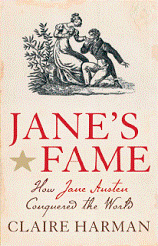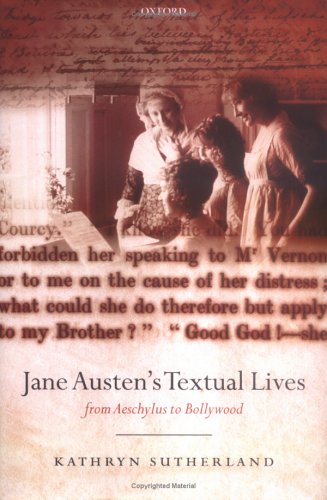Here is an interesting article at the Guardian.co.uk about a new book on Austen by Claire Harman (author of the 2001 biography Fanny Burney) ~ Jane’s Fame: How Jane Austen Conquered the World, to be published next month, and a conflict with the academic writings of Professor Kathryn Sutherland, author of the ground-breaking 2005 Jane Austen’s Textual Lives, from Aeschylus to Bollywood. It’s quite the kerfuffle….


Further reading:
- Claire Harman’s site and more information on her book
- Kathryn Sutherland’s book at Oxford University Press, and a review in JASNA’s Persuasions
[Adding here 3/17/09: I had noted in my comments below that Ellen Moody has addressed this issue in more depth on Austen-L and Janeites as well as her blog, so I add here the link to her post:
http://server4.moody.cx/index.php?id=1016#comment
NB: scroll down further on her blog as there is quite a bit more after the reference to Emily Hahn’s book on Fanny Burney]

Thanks for the heads up Deb. Aren’t the family biographies that Sutherland drew her work from published works that anyone can read and write about? Why are Sutherland’s theories radical? Because Austen’s family attempted to change her public image and the punctuation and grammar in the later printing of the texts?
LikeLike
Hi Deb and Kelly,
Thank you for the information. I’m totally into kerfuffles!
I’ve nominated you for a Sisterhood Award on my blog and am sponsoring a book giveaway contest for Jane Austen sequel or romance writers. Keep up the good work. I love dropping by and learning all sorts of interesting information about Jane A. Vic
LikeLike
What a story, Deb! Claire Harman taught here at Midd one January term. I think my daughter took a class with her. I haven’t read Kathryn Sutherland’s book, but it sounds as if I should.
LikeLike
Hi all, yes, Mary Ellen, the Sutherland book is a must-read (alas! I have only skimmed it, but it is packed with information – a great chapter on the writing and the MSS of Persuasion) – the flack lies in the academic vs. more popular publications. Sutherland apparently shared her research with Harman and was preparing a more popular text of her ideas, but now it seems Harman has done this in her book, but without perhaps as many detailed footnotes that an academic tome requires. Will be interesting to compare the two – you can pre-order the Harman book at Amazon.uk if you cannot wait. [I should add here that Ellen Moody has posted some thoughts on this dispute at Austen-L – worth reading as she knows more about this than I do…]
Thanks all for visiting!
Deb
[and thanks Vic for the Sisterhood Award – I will look at that today and pass it on…!]
LikeLike
I’ve read the Kathryn Sutherland – dull, dull, dull! The woman can’t write a clear sentence for the life of her, and it seems she’s grumpy to boot. Trust me ladies, she couldn’t have reached a wider audience however hard she tried. Good on Harman if she’s produced a lively history of Jane’s Fame.
LikeLike
Thanks Angharad for your thoughts! This is raising quite the ruckus everywhere isn’t it! have to love these academia squabbles. And yes, the Sutherland is a tad dense, but it does present so much information together to be looked at as a piece… and for that her book has been considered ground-breaking. How Austen would love to see all this mud-slinging over her placement of commas, spelling and grammar, and who said what and when about her… even Mark Twain might be amused by it all!
Deb
LikeLike
Ellen Moody wrote about it on her blog yesterday.
http://server4.moody.cx/index.php?id=1016#comment
LikeLike
Thanks Mae, I saw that after I had posted this and refer to Ellen in my comment above. Thanks for the link; I have added it to the post as well…
Deb
LikeLike
This sounds like a media-made (what type of paper is The Guardian??) argument. If Sutherland’s book was PUBLISHED in 2005 the ideas and analyses it presents are out there, for people to argue over, refute or utilize (hopefully citing properly). How different hurt “feelings” would be IF both works were in manuscript and Harman’s saw publication first — but that is not the case here.
I read and enjoyed Harman’s Burney biography (and will look at it again with an eye to scholarly vs popular), and looked forward (still do so) to the release of her Austen book.
The one question I had: what are these continued comments regarding Austen’s MANUSCRIPTS??? Sutherland’s contentions seem to be, according to The Guardian, that punctution (really??!!) underwent changes from Manuscript to publication in the Victorian era: “Sutherland uncovered evidence that the punctuation inserted on Austen’s manuscripts shows how she was turned into a more acceptable and organised kind of creative genius.” Except for the Persuasion chapters there exist NO manuscripts – and punctuation helps clarify sentences – but how can it obscure creative genius?
Anyone who’s dealt with printers know – errors happen, and recur (or multiply sometimes) when you try to FIX the first error… Don’t read ‘conspiracy’ where there was no such thing.
This sounds HYPE (from whose camp…??) with a capital H. The books will rise and fall on their own merits. A scholarly book will be popular if it is well written and well-supported; a popular book will fall if the research is sloppy.
Is Sutherland really that bound up in punctuation?? If so, then I’d recommend the FIRST editions of Austen’s novels — some of which blog readers will find linked in our Bibliography section.
LikeLike
Hi Kelly, just to clarify a few things… there ARE a good number other manuscripts of Austen’s works, but only the cancelled chapters from Persuasion exist from her 6 NOVELS. There are MSS for the Juvenilia, The Watsons, Sanditon and of course all the extant letters. [See Brian Southam’s “Jane Austen’s Literary Manuscripts” for an analysis of these.] Also, Austen herself made changes to those of her novels that went into 2nd editions (P&P and MP to be specific). At the 2008 AGM, Emily Auerbach spoke on how as an editor, the placement of a coma in a passage in MP, caused her to have visions about what Austen really might have meant, as there was a change in comma placement in the 2nd edition that Austen oversaw – was it a printer’s mistake, her requested change, or an editor’s change? – and the meaning of the sentence shifted with this move of the comma. Herein lies the work of the editor -and all that goes with the subjective personal and social cultural times of the editor. As I have said, I have only skimmed the Sutherland book and read chapters as needed, so I am ill equipped to discuss the book, but The Guardian is a respected paper in the UK and they were only reporting the flack – it has been reported elsewhere as well.
Harman’s work is likened to Claire Tomalin – a scholar who can tell a great story, as the terrific Fanny Burney biography shows very clearly. It is likely sour grapes on Sutherland’s part that this new work will be more readable than what she can produce. But as for this emphasis on punctuation and spelling, etc. – Austen was known for not being exact on any of those points – and subsequent editing of the published novels made many changes – this is what Sutherland addresses, esp the work done by Chapman for the Oxford editions – all his works were accepted as doctrine until manuscripts became available and some of these editor decisions are being looked at critically. No one is questioning Austen’s creative genius – she was her own best editor as we know…
Anyway, I look forward to reading the new work as soon as it is available and see what all the kerfuffle is about!
Deb
LikeLike
Pingback: “Jane’s Fame” ~ the Reviews « Jane Austen in Vermont
Pingback: Book Review ~ “Jane’s Fame” by Claire Harman « Jane Austen in Vermont
Pingback: Jane Austen’s Fiction Manuscripts Digitized « Jane Austen in Vermont